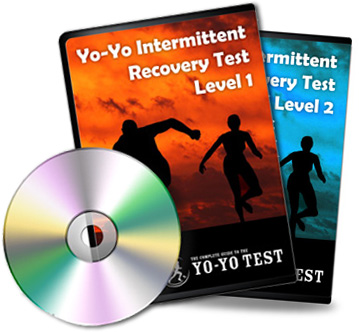Submaximal Yo-Yo Tests
In addition to the six official yo-yo test versions as created by Jens Bangsbo, there are a few modified versions of the yo-yo test that have made changes to the original protocols for a specific purpose, such as a submaximal version (e.g. Yo-Yo IR1-SUB).
The standard versions of the yo-yo test are maximal tests, meaning that the tests progress until volitional exhaustion. However, it is not always appropriate to conduct a maximal test on athletes, particularly during the competitive season or during the rehabilitation of an injured player. In these cases, you may want to conduct a submaximal test as a non-exhaustive alternative to monitor their fitness.
The yo-yo test has been used as a submaximal test, running only for a set number of sprints or set time period (e.g. 4 or 6 minutes). In this way, all athletes who perform this test will do the same exercise workload. Heart rate measurements are used during these sub-maximal versions of the yo–yo test to provide information about the fitness level of the athletes.
A six-minute submaximal yo-yo test is commonly used. If the participants are able to wear a heart rate monitor, then you can record and compare the heart rate response throughout the test. The heart rate at the completion of the test (at the 6 minute mark) or the average heart rate during the last 30 seconds can be compared.

Bradley et al. (2011) used sub-maximal versions of the Yo–Yo IE2 test, lasting either 4 minutes (600 m) or 6 minutes (920 m). The Yo–Yo IR1 has also been used as the basis of the submaximal test used by Owen et al. (2017), running the first six minutes of the test, covering 720 meters.
As all athletes in the submaximal test stop at the same point, they will not have a final test score to get a fitness rating or convert their score to VO2max. However, performance in these sub-maximal tests can be assessed by measuring the heart rate during and following the completion of the test. Owen et al. (2017) found that in elite youth soccer players the final heart rate at the end of the 6-minute test was the most reliable metric, while the heart rate after 2 minutes, expressed as a percentage of maximum value, was the most reliable recovery metric.
References
- Bradley PS, Mohr M, Bendiksen M, Randers MB, Flindt M, Barnes C, Hood P, Gomez A, Andersen JL, Di Mascio M, Bangsbo J, Krustrup P. (2011). Sub-maximal and maximal Yo-Yo intermittent endurance test level 2: heart rate response, reproducibility and application to elite soccer. Eur J Appl Physiol. Jun;111(6):969-78. doi: 10.1007/s00421-010-1721-2.
- Bradley PS, Di Mascio M, Bangsbo J, Krustrup P. (2012). The maximal and submaximal versions of the Yo-Yo intermittent endurance test level 2 are simply reproducible, sensitive and valid. Eur J Appl Physiol;112: 1973-1975
- Owen, Charlie & Jones, Paul & Comfort, Paul. (2017). The reliability of the submaximal version of the Yo-Yo intermittent recovery test in elite youth soccer. Journal of Trainology. 6. 31-34. 10.17338/trainology.6.1_31.
More Resources
- Other modifications of the yo-yo tests
- About the six variations of the yo-yo fitness test
- How to determine which version of the yo-yo test you did
- Alternatives to the Yo-Yo Test
- Buy the Yo-Yo Test files
- List of information pages
Cite this Page


